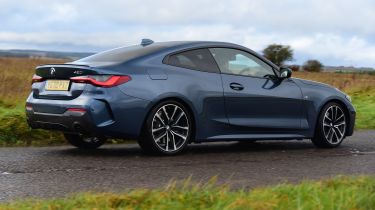BMW 4 Series coupe - MPG, running costs & CO2
Its petrol and diesel engines are efficient but a plug-in hybrid is unconfirmed
BMW tends to offer a wide range of engines, and there are plenty of petrol and diesel choices for the 4 Series. Choose the former in 420i guise and you can expect over 40mpg and a fairly high BiK band but many buyers are expected to take this route. Pick a diesel and mild-hybrid technology is fitted, helping push the mpg figure into the 50s, while mid-level BiK numbers should also appeal to company-car customers.
While an all-electric 4 Series is very unlikely, customers looking for a zero-emissions version will be steered towards the BMW i4. A similar size, this is expected to boast an 80kWh battery, giving it an electric range of around 370 miles.
BMW 4 Series MPG & CO2
Every regular version of the 4 Series is affordable to run, with the entry-level 420i petrol engine officially capable of between 39.8 to 44.1mpg depending on if you opt for the rear- or four-wheel drive and CO2 emissions starting from 146g/km. Despite having more power, the engine in the 430i doesn't come with significantly higher running costs either, returning around 42mpg and emission of 153g/km. While the flagship M440i version is the most powerful petrol unit, it still officially returns up to 36.7mpg while emitting up to 178g/km of CO2.
More reviews
Unlike some manufacturers, BMW is sticking with diesel engines, and its 420d model should suit plenty of high-mileage drivers. Fitted with mild-hybrid hardware that recoups energy under deceleration, it returns up to 60.1mpg depending on the trim level, with CO2 emissions from 122g/km. A four-wheel drive xDrive option is also offered, dropping fuel economy by around 5mpg. A high-performance M440d xDrive is also available, and is capable of returning up to 47.9mpg. Emissions for the flagship diesel are reasonable, too, starting from 154g/km.
Insurance groups
Even the basic 4 Series coupe is a quick, desirable car, so the cost of insurance isn't to be sniffed at. The 420i M Sport starts in group 30 out of 50, while the 430i M Sport Pro Edition is in group 35. Meanwhile, the entry-level diesel 420d M Sport is in group 32.
Warranty
BMW offers buyers a three-year, unlimited mileage warranty, which also includes three years of roadside assistance. It's on a par with Mercedes and is slightly better than Audi, which imposes a 60,000-mile limit. It's also possible to extend the BMW's warranty at extra cost.
Servicing
BMW models are fitted with sensors that monitor the car and determine when servicing is required. Visits for maintenance are usually no more than two years or 20,000 miles apart, but this varies depending on how the car is used and driven.










